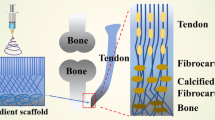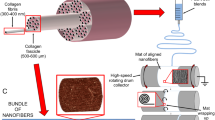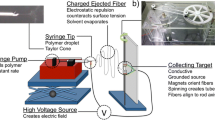Abstract
Two-dimensional (2D) electrospun fibre mats have been investigated as fibrous sheets intended as biomaterials scaffolds for tissue repair. It is recognised that tissues are three-dimensional (3D) structures and that optimisation of the fabrication process should include both 2D and 3D scaffolds. Understanding the relative merits of the architecture of 2D and 3D scaffolds for tendon repair is required. This study investigated three different electrospun scaffolds based on poly(ε-caprolactone) fibres intended for repair of injured tendons, referred to as; 2D random sheet, 2D aligned sheet and 3D bundles. 2D aligned fibres and 3D bundles mimicked the parallel arrangement of collagen fibres in natural tendon and 3D bundles further replicated the tertiary layer of a tendon’s hierarchical configuration. 3D bundles demonstrated greatest tensile properties, being significantly stronger and stiffer than 2D aligned and 2D random fibres. All scaffolds supported adhesion and proliferation of tendon fibroblasts. Furthermore, 2D aligned sheets and 3D bundles allowed guidance of the cells into a parallel, longitudinal arrangement, which is similar to tendon cells in the native tissue. With their superior physical properties and ability to better replicate tendon tissue, the 3D electrospun scaffolds warrant greater investigation as synthetic grafts in tendon repair.






Similar content being viewed by others
References
Pintore E, Barra V, Pintore R, Maffulli N. Peroneus brevis tendon transfer in neglected tears of the Achilles tendon. J Trauma. 2001;50(1):71–8.
Wilcox DK, Bohay DR, Anderson JG. Treatment of chronic achilles tendon disorders with flexor hallucis longus tendon transfer/augmentation. Foot Ankle Int. 2000;21(12):1004–10.
Mann RA, Holmes GB Jr, Seale KS, Collins DN. Chronic rupture of the Achilles tendon: a new technique of repair. J Bone Joint Surg Am. 1991;73(2):214–9.
Kew SJ, Gwynne JH, Enea D, Abu-Rub M, Pandit A, Zeugolis D, Brooks RA, Rushton N, Best SM, Cameron RE. Regeneration and repair of tendon and ligament tissue using collagen fibre biomaterials. Acta Biomater. 2011;7(9):3237–47.
Schnee CL, Freese A, Weil R, Marcotte P. Analysis of harvest morbidity and radiographic outcome using autograft for anterior cervical fusion. Spine. 1997;22(19):2222–7.
Williams RJ 3rd, Hyman J, Petrigliano F, Rozental T, Wickiewicz TL. Anterior cruciate ligament reconstruction with a four-strand hamstring tendon autograft. J Bone Joint Surg Am. 2004;86-A(2):225–32.
Barker JU, Drakos MC, Maak TG, Warren RF, Williams RJ 3rd, Allen AA. Effect of graft selection on the incidence of postoperative infection in anterior cruciate ligament reconstruction. Am J Sports Med. 2010;38(2):281–6.
Kumbar SG, Nukavarapu SP, James R, Nair LS, Laurencin CT. Electrospun poly(lactic acid-co-glycolic acid) scaffolds for skin tissue engineering. Biomaterials. 2008;29(30):4100–7.
Bassi AK, Gough JE, Downes S. A novel phosphonate for the repair of critical size bone defects. J Tissue Eng Regen Med. 2011;Ahead of print.
Wang H, Feng Y, Zhao H, Xiao R, Lu J, Zhang L, Guo J. Electrospun hemocompatible PU/Gelatin-Heparin nanofibre bilayer scaffolds as potential artificial blood vessels. Macromol Res. 2012;20(4):347–50.
Ricotti L, Polini A, Genchi GG, Ciofani G, Iandolo D, Vazão H, Mattoli V, Ferreira L, et al. Proliferation and skeletal myotube formation capability of C2C12 and H9c2 cells on isotropic and anisotropic electrospun nanofibrous PHB scaffolds. Biomed Mater. 2012;7(3):035010.
Bonino CA, Efimenko K, Jeong SI, Krebs MD, Alsberg E, Khan SA. Three-dimensional electrospun alginate nanofiber mats via tailored charge repulsions. Small. 2012;8(12):1928–36.
Nisbet DR, Forsythe JS, Shen W, Finkelstein DI, Horne MK. Review paper: a review of the cellular response on electrospun nanofibers for tissue engineering. J Biomater Appl. 2009;24(1):7–29.
Simonet M, Driessen-Mol A, Baaijens FPT, Bouten CVC. Heart valve tissue regeneration. In: Bosworth LA, Downes S, editors. Electrospinning for tissue regeneration book. Cambridge: Woodhead Publishers; 2011. p. 202–24.
Vaz CM, van Tuijl S, Bouten CVC, Baaijens FPT. Design of scaffolds for blood vessel tissue engineering using a multi-layering electrospinning technique. Acta Biomater. 2005;1(5):575–82.
Acocella F, Brizzola S. Tracheal tissue regeneration. In: Bosworth LA, Downes S, editors. Electrospinning for tissue regeneration book. Cambridge: Woodhead Publishers; 2011. p. 242–79.
Moffat KL, Kwei AS-P, Spalazzi JP, Doty SB, Levine WN, Lu HH. Novel nanofiber-based scaffold for rotator cuff repair and augmentation. Tissue Eng A. 2009;15(1):115–26.
Yin Z, Chen X, Chen JL, Shen WL, Nguyen TMH, Gao L, Ouyang HW. The regulation of tendon stem cell differentiation by the alignment of nanofibers. Biomaterials. 2010;31(8):2163–75.
James R, Kumbar SG, Laurencin CT, Balian G, Chhabra AB. Tendon tissue engineering: adipose-derived stem cell and GDF-5 mediated regeneration using electrospun matrix systems. Biomed Mater. 2011;6(2):025011.
Kannus P. Structure of the tendon connective tissue. Scand J Med Sci Sports. 2000;10(6):312–20.
Sharma P, Maffulli N. Basic biology of tendon injury and healing. The Surgeon. 2005;3(5):309–16.
Screen HR, Lee DA, Bader DL, Shelton JC. An investigation into the effects of the hierarchical structure of tendon fascicles on micromechanical properties. Proc Inst Mech Eng [H]. 2004;218(2):109–19.
Maffulli N, Moller HD, Evans CH. Tendon healing: can it be optimised? Br J Sports Med. 2002;36(5):315–6.
Bosworth LA, Downes S. Physiochemical characterisation of degrading polycaprolactone scaffolds. Polym Degrad Stabil. 2010;95:2269–76.
Mo XM, Xu CY, Kotaki M, Ramakrishna S. Electrospun P(LLA-CL) nanofiber: a biomimetic extracellular matrix for smooth muscle cell and endothelial cell proliferation. Biomaterials. 2004;25(10):1883–90.
Taylor SE, Vaughan-Thomas A, Clements DN, Pinchbeck G, Macrory LC, Smith RKW, et al. Gene expression markers of tendon fibroblasts in normal and diseased tissue compared to monolayer and three dimensional culture systems. BMC Musculoskelet Disord. 2009;10:27.
Tzezana R, Zussman E, Levenberg S. A layered ultra-porous scaffold for tissue engineering, created via a hydrospinning method. Tissue Eng C. 2008;14(4):281–8.
Yang F, Murugan R, Wang S, Ramakrishna S. Electrospinning of nano/micro scale poly(l-lactic acid) aligned fibers and their potential in neural tissue engineering. Biomaterials. 2005;26(15):2603–10.
Vaquette C, Kahn C, Frochot C, Nouvel C, Six J-L, De Isla N, Luo L-H, Cooper-White J, Rahouadj R, Wang X. Aligned poly(l-lactic-co-e-caprolactone) electrospun microfibers and knitted structure: a novel composite scaffold for ligament tissue engineering. J Biomed Mater Res A. 2010;94A(4):1270–82.
Li W-J, Mauck RL, Cooper JA, Yuan X, Tuan RS. Engineering controllable anisotropy in electrospun biodegradable nanofibrous scaffolds for musculoskeletal tissue engineering. J Biomech. 2007;40(8):1686–93.
Baker SC, Atkin N, Gunning PA, Granville N, Wilson K, Wilson D, Southgate J. Characterisation of electrospun polystyrene scaffolds for three-dimensional in vitro biological studies. Biomaterials. 2006;27(16):3136–46.
Freeman JW, Woods MD, Laurencin CT. Tissue engineering of the anterior cruciate ligament using a braid-twist scaffold design. J Biomech. 2007;40:2029–36.
Wang JH-C. Mechanobiology of tendon. J Biomech. 2006;39(9):1562–82.
Soejima O, Diao E, Lotz JC, Hariharan JS, Naito M. Dorsal and palmar material properties of the adult human flexor profundus tendon in zone II. Hand Surgery. 2003;8(1):53–8.
Wren TAL, Yerby SA, Beaupré GS, Carter DR. Mechanical properties of the human achilles tendon. Clin Biomech. 2001;16(3):245–51.
Cooper JA, Lu HH, Ko FK, Freeman JW, Laurencin CT. Fiber-based tissue-engineered scaffold for ligament replacement: design considerations and in vitro evaluation. Biomaterials. 2005;26(13):1523–32.
Pham QP, Sharma U, Mikos AG. Electrospun poly(ε-caprolactone) microfiber and multilayer nanofiber/microfiber scaffolds: characterization of scaffolds and measurement of cellular infiltration. Biomacromolecules. 2006;7(10):2796–805.
Balguid A, Mol A, van Marion MH, Bank RA, Bouten CVC, Baaijens FPT. Tailoring fiber diameter in electrospun (poly(ε-caprolactone) scaffolds for optimal cellular infiltration in cardiovascular tissue engineering. Tissue Eng A. 2009;15(2):437–44.
Cai S, Smith ME, Redenti SM, Wnek GE, Young MJ. Mouse retinal progenitor cell dynamics on electrospun poly(ε-caprolactone). J Biomater Sci Polym Ed. 2012;23:1451–65.
Chew SY, Mi R, Hoke A, Leong KW. The effect of the alignment of electrospun fibrous scaffolds on Schwann cell maturation. Biomaterials. 2008;29(6):653–61.
Shang S, Yang F, Cheng X, Walboomers XF, Jansen JA. The effect of electrospun fibre alignment on the behaviour of rat periodontal ligament cells. Eur Cells Mater. 2010;19:180–92.
Acknowledgments
The Authors’ wish to thank the EPSRC for funding this research and Prof. P.D. Clegg, The University of Liverpool, for donation of tendon fibroblasts.
Disclosures
The authors declare no conflicts of interest.
Author information
Authors and Affiliations
Corresponding author
Rights and permissions
About this article
Cite this article
Bosworth, L.A., Alam, N., Wong, J.K. et al. Investigation of 2D and 3D electrospun scaffolds intended for tendon repair. J Mater Sci: Mater Med 24, 1605–1614 (2013). https://doi.org/10.1007/s10856-013-4911-8
Received:
Accepted:
Published:
Issue Date:
DOI: https://doi.org/10.1007/s10856-013-4911-8




